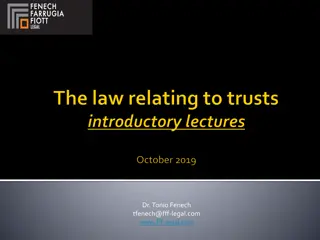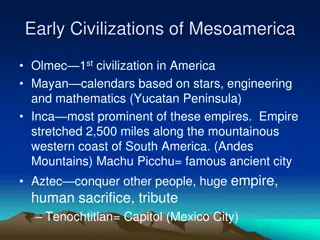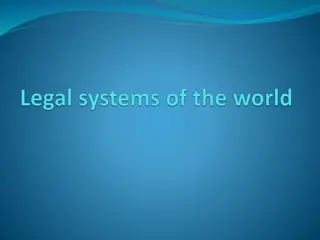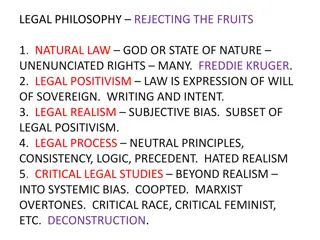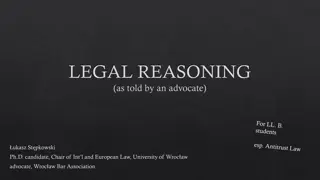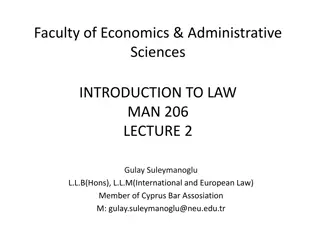Evolution of North American Law: From Common Law to Unique Legal Tradition
The historical origins of North American law trace back to the early 17th century, marked by the influence of English common law on the colonies. Over time, the American legal system evolved, absorbing elements from both the English legal tradition and local statutes. The development of the United States legal framework reflects a blend of historical events such as the Declaration of Independence and the Civil War, shaping a distinct legal heritage that has significantly impacted global jurisprudence.
Download Presentation

Please find below an Image/Link to download the presentation.
The content on the website is provided AS IS for your information and personal use only. It may not be sold, licensed, or shared on other websites without obtaining consent from the author. Download presentation by click this link. If you encounter any issues during the download, it is possible that the publisher has removed the file from their server.
E N D
Presentation Transcript
Comparative Law Prof.ssa Letizia Coppo
THE COMMON LAW TRADITION (NORTH) AMERICAN LAW
HISTORICAL ORIGINS The North American legal family has recent origins compared to the ones of the other traditions. The first relevant period is the first half of the XVII century, the time of the famous 13 colonies. They had little contacts with each others and their links with England were rather loose. There was no need for courts or lawyers; securing survival was the priority.
HISTORICAL ORIGINS Possible disputes were settled by ministers with the Bible, rather than by lawyers with the common law. At the beginning of XVIII century, the increasing trade among the colonies and with England strengthened the connection with the mother country. England, with its Inns, became the reference point for training and Blackstone s work spread English law.
HISTORICAL ORIGINS Colonies agreed that their governing law should be in principle the common law of England, supplemented by local statutes. But several people moved to America right because they were politically, spiritually or economically oppressed by their home country. Thus, several statutes were enacted. A thirst for a more egalitarian and democratic society and the ideals of the French Revolution lead to an alteration of English law.
HISTORICAL ORIGINS Since then, the most relevant events have been: 1. the independence war, which lead to the 1786 Declaration of Independence and to the 1789 Federal Constitution (the core of which is still in force), signed by several lawyers; 2. the 1861-1865 secession war, with all the problem of slavery, that has been haunting the US for a long time.
HISTORICAL DEVELOPMENT The US have gradually become one of the most influential countries in the world and the essence of such development can be identified in the double institutional heritage of the two legal families of the Western Legal Tradition that American law has been capable of metabolising and transforming into something original.
HISTORICAL DEVELOPMENT From common law, through Blackstone, American law inherited a strong, powerful, independent and prestigious judiciary, main character of the whole legal history of the country. From civil law (especially the German family), American law inherited influential law schools and streams of legal thought.
HISTORICAL DEVELOPMENT The result was the elaboration of original models, flexible and capable of adapting to different legal context, therefore suitable for circulation and transplant. The peculiarities of the Judiciary, linked with the strong influence of the Constitution and the Federal structure, and the peculiarities of American law schools and legal profession are the most distinctive elements of the system.
THE CONSTITUTION AND THE JUDICIAL REVIEW The judicial review is the main tool that enabled the judiciary to acquire its leading institutional role in the US legal system, since Marbury v. Madison. Basically every judge is entitled to check the compliance of statutes or administrative acts with the Constitution. In case of non- compliance, the single courts are entitled to disregard the statute or act. Only the Supreme Court, though, has the power to declare the act unconstitutional.
THE CONSTITUTION AND THE JUDICIAL REVIEW The up-taking of the Supreme Court role is linked to the character of Chief Justice Marshall. With Marbury v. Madison he held that the Supreme Court was entitled to review the compliance of federal statutes with the federal Constitution. He held that the Supreme Court had the power to declare State laws unconstitutional and overturn state courts decisions.
THE CONSTITUTION AND THE JUDICIAL REVIEW A remarkable invention by Marshall was the opinion of the court , which gives Chief Justices a great power, as he commits him the choice of the justice who will speak in the name of the Court as a whole. One voice (unanimity or majority) and one holding. Dissenting opinions existed, but were looked at suspiciously as they are a hint of a possible fragmentation of the Court s unity.
THE CONSTITUTION AND THE JUDICIAL REVIEW Structure of the Constitution 7 original articles that show the conflict between federalist ideas, willing to build a unitary State, and the fear that a firm union would kill the rights, powers and sovereignty of the single States. The key principle was Montesquieu s separation of powers.
THE CONSTITUTION AND THE JUDICIAL REVIEW Arts 1,2,3: organisational provisions and some provisions on individual rights: eg prohibition of ex post facto laws; right to a trial by jury and to natural judge. Art 6: Supremacy clause : the Constitution shall be the supreme law of the land. Constitutional pyramid with the Supreme Court (and its overruling power) on top.
THE CONSTITUTION AND THE JUDICIAL REVIEW Amendments coming from the Bill of Rights (1791): while the English Bill of Rights, enacted under the Stuarts, basically contained political rights (together with some individual rights like the one against cruel and unusual punishment), the American one was focused on individual rights. The American Bill of Rights was influenced by natural law and Enlightenment ideas. The list of rights was typical and prevalent.
THE CONSTITUTION AND THE JUDICIAL REVIEW First Amendment: establishment clause. Freedom of religion, speech, press, assembly and petition to the government. Fourth Amendment: prohibition of unreasonable searches and seizures. Procedural rights. Fifth Amendment: right to a Grand Jury; double jeopardy prohibition; nemo tenetur se detegere; due process and just compensation clause;
THE CONSTITUTION AND THE JUDICIAL REVIEW Procedural due process: right to a fair trial; freedom, life and property cannot be infringed without formal guarantees, among witch the right to equality of arms an to a trial by jury. Substantive due process: void for vagueness clause; culpability; freedom of contract (see how the latter hindered the enforcement of Roosvelt s New Deel policies on labor law).
THE CONSTITUTION AND THE JUDICIAL REVIEW VI Amendment: right to a public and speedy trial; right to a trial by jury; right to be acquainted with the nature and ground for accusation; right to witnesses and to cross-examination. VIIAmendment: right to a trial by jury also in civil disputes. VIII Amendment: habeas corpus and prohibition of cruel and unusual penalties.
THE CONSTITUTION AND THE JUDICIAL REVIEW IX Amendment: The list of rights contained in the Constitution cannot be interpreted as to exclude or limit other rights. X Amendment: the powers that are not expressly awarded by the Constitution to the Union keep un belonging to the States.



